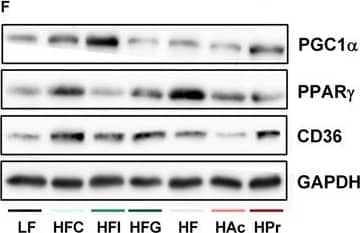Mouse CD36/SR-B3 Antibody Summary
Gly30-Lys439
Accession # Q08857
Applications
Please Note: Optimal dilutions should be determined by each laboratory for each application. General Protocols are available in the Technical Information section on our website.
Scientific Data
 View Larger
View Larger
Detection of Mouse CD36/SR-B3 by Western Blot Inulin and SCFA prevent the onset of diet-induced hepatic steatosis by affecting lipid metabolism in different ways. Characterization of liver tissue in male C57BL/6JRj mice that were fed a semi-synthetic low-fat diet (LF) or high-fat diets (HF) supplemented with either 10% dietary fibre (HFC: 10% cellulose; HFI: 3% cellulose + 7% inulin; HFG: 3% cellulose + 7% guar gum; depicted in green hues) or 5% SCFA (depicted in red hues) with different Ac:Pr ratios, a high acetate (HAc; 10:1 Ac:Pr) or high propionate diet (HPr; 1:2.5 Ac:Pr) for 30 weeks. (A) Representative H&E staining of hepatocytes after intervention. (B) Liver tissue weight (n = 19–21) and corresponding (C) hepatic triglyceride (TG) concentration, n = 9–11. (D) Formation of odd-chain fatty acids (OCFA) in liver phospholipid fraction, n = 8. (E) Hepatic gene expression, (F) respective western blots with corresponding load control (GAPDH) and (G) analysis of protein expression (normalized to LF-diet as set to a value of 1), n = 4–8. Analysis of (H) citrate synthase (CS) and (I) cytochrome c oxidase (COX) activity in liver, n = 5–8. (J) Hepatic fatty acid synthase (FASN) activity and (K) calculated de novo lipogenesis (DNL)-Index by measurement of long-chain fatty acid amount in liver phospholipids, n = 8. Data are mean + SEM. *P < 0.05; **P < 0.01; ***P < 0.001. Image collected and cropped by CiteAb from the following publication (https://pubmed.ncbi.nlm.nih.gov/28733671), licensed under a CC-BY license. Not internally tested by R&D Systems.
Preparation and Storage
- 12 months from date of receipt, -20 to -70 °C as supplied.
- 1 month, 2 to 8 °C under sterile conditions after reconstitution.
- 6 months, -20 to -70 °C under sterile conditions after reconstitution.
Background: CD36/SR-B3
CD36 (alternatively known as platelet membrane glycoprotein IV (GPIV), thrombospondin receptor, fatty acid translocase (FAT), and scavenger receptor class B, member 3 (SR-B3)) is an 88 kDa, integral membrane glycoprotein that belongs to the class B scavenger receptor family (1, 2). The molecule is described as being ditopic, with two transmembrane segments connected by an extracellular loop (3). Mouse CD36 is synthesized as a 472 amino acid (aa) protein that contains a 6 aa N‑terminal cytoplasmic domain, a 22 aa N‑terminal transmembrane segment, a 420 aa extracellular “loop”, a 22 aa C‑terminal transmembrane segment, and a 9 aa C‑terminal cytoplasmic tail (4). Both cytoplasmic tails are palmitoylated, with the C‑terminal tail involved in oxidized LDL binding (5, 6). With respect to the extracellular loop, the N‑terminal region is believed to bind both thrombospondin-1 and Plasmodium-infected erythrocytes. Other ligands for CD36 include long-chain fatty acids, collagen, phospholipids and apoptotic cells (1). The extracellular loop of mouse CD36 is 94%, 92%, 84%, and 84% aa identical to the extracellular loops of rat, hamster, human, and bovine CD36, respectively. Cells known to express CD36 include capillary endothelium, adipocytes, skeletal muscle cells, intestinal epithelium, smooth muscle cells, and hematopoietic cells such as red blood cells, platelets, and monocytes (1). On the surface of cells, CD36 is suggested to exist as a dimer in response to ligation (7). CD36 is reported to regulate fatty uptake, act as an angiogenic with TSP-1, and participate in the clearance of apoptotic phagocytes (1, 8).
- Febbraio, M. et al. (2001) J. Clin. Invest. 108:795.
- Silverstein, R.L. and M. Febbraio (2000) Curr. Opin. Lipid. 11:483.
- Gruarin, P. et al. (2000) Biochem. Biophys. Res. Commun. 275:446.
- Endemann, G. et al. (1993) J. Biol. Chem. 268:11811.
- Malaud, E. et al. (2002) Biochem. J. 364:507.
- Tao, N. et al. (1996) J. Biol. Chem. 271:22315.
- Daviet, L. et al. (1997) Thromb. Haemost. 78:897.
- Simantov, R. and R.L. Silverstein (2003) Front. Biosci. 8:s874.
Product Datasheets
Citations for Mouse CD36/SR-B3 Antibody
R&D Systems personnel manually curate a database that contains references using R&D Systems products. The data collected includes not only links to publications in PubMed, but also provides information about sample types, species, and experimental conditions.
5
Citations: Showing 1 - 5
Filter your results:
Filter by:
-
Short-chain fatty acids and inulin, but not guar gum, prevent diet-induced obesity and insulin resistance through differential mechanisms in mice
Authors: Karolin Weitkunat, Christin Stuhlmann, Anna Postel, Sandra Rumberger, Maria Fankhänel, Anni Woting et al.
Scientific Reports
-
RDH1 suppresses adiposity by promoting brown adipose adaptation to fasting and re-feeding
Authors: Charles R. Krois, Marta G. Vuckovic, Priscilla Huang, Claire Zaversnik, Conan S. Liu, Candice E. Gibson et al.
Cellular and Molecular Life Sciences
-
Obesity and weight loss result in increased adipose tissue ABCG1 expression in db/db mice.
Authors: Edgel KA, McMillen TS, Wei H et al.
Biochim Biophys Acta
-
Activation of AMPKalpha2 is not crucial for mitochondrial uncoupling-induced metabolic effects but required to maintain skeletal muscle integrity.
Authors: Ost M, Werner F, Dokas J, Klaus S, Voigt A
PLoS ONE, 2014-04-14;9(4):e94689.
Species: Mouse
Sample Types: Tissue Homogenates
Applications: Western Blot -
Muscle mitochondrial stress adaptation operates independently of endogenous FGF21 action
Authors: Mario Ost, Verena Coleman, Anja Voigt, Evert M. van Schothorst, Susanne Keipert, Inge van der Stelt et al.
Molecular Metabolism
FAQs
No product specific FAQs exist for this product, however you may
View all Antibody FAQsReviews for Mouse CD36/SR-B3 Antibody
There are currently no reviews for this product. Be the first to review Mouse CD36/SR-B3 Antibody and earn rewards!
Have you used Mouse CD36/SR-B3 Antibody?
Submit a review and receive an Amazon gift card.
$25/€18/£15/$25CAN/¥75 Yuan/¥2500 Yen for a review with an image
$10/€7/£6/$10 CAD/¥70 Yuan/¥1110 Yen for a review without an image




